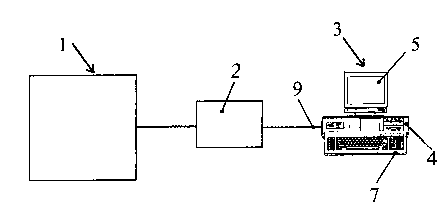Une partie des informations de ce site Web a été fournie par des sources externes. Le gouvernement du Canada n'assume aucune responsabilité concernant la précision, l'actualité ou la fiabilité des informations fournies par les sources externes. Les utilisateurs qui désirent employer cette information devraient consulter directement la source des informations. Le contenu fourni par les sources externes n'est pas assujetti aux exigences sur les langues officielles, la protection des renseignements personnels et l'accessibilité.
L'apparition de différences dans le texte et l'image des Revendications et de l'Abrégé dépend du moment auquel le document est publié. Les textes des Revendications et de l'Abrégé sont affichés :
| (12) Demande de brevet: | (11) CA 2344366 |
|---|---|
| (54) Titre français: | PROCESSUS ET SYSTEME POUR USINER UNE PIECE A L'AIDE DE MACHINES-OUTILS A COMMANDE NUMERIQUE |
| (54) Titre anglais: | PROCESS AND SYSTEM FOR WORKING A WORKPIECE THROUGH NUMERICALLY CONTROLLED MACHINE TOOLS |
| Statut: | Réputée abandonnée et au-delà du délai pour le rétablissement - en attente de la réponse à l’avis de communication rejetée |
| (51) Classification internationale des brevets (CIB): |
|
|---|---|
| (72) Inventeurs : |
|
| (73) Titulaires : |
|
| (71) Demandeurs : |
|
| (74) Agent: | |
| (74) Co-agent: | |
| (45) Délivré: | |
| (86) Date de dépôt PCT: | 1999-09-01 |
| (87) Mise à la disponibilité du public: | 2000-04-06 |
| Licence disponible: | S.O. |
| Cédé au domaine public: | S.O. |
| (25) Langue des documents déposés: | Anglais |
| Traité de coopération en matière de brevets (PCT): | Oui |
|---|---|
| (86) Numéro de la demande PCT: | PCT/IT1999/000277 |
| (87) Numéro de publication internationale PCT: | WO 2000019285 |
| (85) Entrée nationale: | 2001-03-15 |
| (30) Données de priorité de la demande: | ||||||
|---|---|---|---|---|---|---|
|
L'invention concerne un processus et un système permettant d'usiner une pièce à l'aide de machines-outils à commande numérique. Le processus de cette invention consiste: à lire une représentation électronique d'un objet destiné à être usiné, puis à mémoriser cette représentation; éventuellement à calculer un modèle mathématique interne dudit objet, en fonction des données produites au cours de l'étape de lecture; à utiliser plusieurs paramètres de mouvement d'un outil destiné à usiner l'objet, ces paramètres concernant notamment les sens, les limites spatiales, et les types de mouvements de cet outil; et à déplacer en temps réel une machine-outil, en fonction de la représentation électronique lue ou du modèle calculé, et des paramètres utilisés.
A process and a system are described for working a workpiece through
numerically controlled machine tools. The process comprises the steps of:
reading an electronic representation of an object to be worked and storing it;
possibly computing an internal mathematical model of the object based on data
obtained from the reading step; providing a plurality of movement parameters
of a tool for working the object, these parameters including directions, space
limits and movement typologies; and real-time moving a working tool based on
the electronic representation being read or the computed model and on the
provided parameters.
Note : Les revendications sont présentées dans la langue officielle dans laquelle elles ont été soumises.
Note : Les descriptions sont présentées dans la langue officielle dans laquelle elles ont été soumises.

2024-08-01 : Dans le cadre de la transition vers les Brevets de nouvelle génération (BNG), la base de données sur les brevets canadiens (BDBC) contient désormais un Historique d'événement plus détaillé, qui reproduit le Journal des événements de notre nouvelle solution interne.
Veuillez noter que les événements débutant par « Inactive : » se réfèrent à des événements qui ne sont plus utilisés dans notre nouvelle solution interne.
Pour une meilleure compréhension de l'état de la demande ou brevet qui figure sur cette page, la rubrique Mise en garde , et les descriptions de Brevet , Historique d'événement , Taxes périodiques et Historique des paiements devraient être consultées.
| Description | Date |
|---|---|
| Exigences relatives à la révocation de la nomination d'un agent - jugée conforme | 2021-04-01 |
| Demande non rétablie avant l'échéance | 2005-09-01 |
| Le délai pour l'annulation est expiré | 2005-09-01 |
| Réputée abandonnée - omission de répondre à un avis sur les taxes pour le maintien en état | 2004-09-01 |
| Inactive : Abandon.-RE+surtaxe impayées-Corr envoyée | 2004-09-01 |
| Inactive : Page couverture publiée | 2001-06-07 |
| Inactive : CIB en 1re position | 2001-06-03 |
| Lettre envoyée | 2001-05-25 |
| Inactive : Notice - Entrée phase nat. - Pas de RE | 2001-05-25 |
| Demande reçue - PCT | 2001-05-17 |
| Demande publiée (accessible au public) | 2000-04-06 |
| Date d'abandonnement | Raison | Date de rétablissement |
|---|---|---|
| 2004-09-01 |
Le dernier paiement a été reçu le 2003-08-29
Avis : Si le paiement en totalité n'a pas été reçu au plus tard à la date indiquée, une taxe supplémentaire peut être imposée, soit une des taxes suivantes :
Veuillez vous référer à la page web des taxes sur les brevets de l'OPIC pour voir tous les montants actuels des taxes.
| Type de taxes | Anniversaire | Échéance | Date payée |
|---|---|---|---|
| Taxe nationale de base - générale | 2001-03-15 | ||
| Enregistrement d'un document | 2001-03-15 | ||
| TM (demande, 2e anniv.) - générale | 02 | 2001-09-04 | 2001-08-27 |
| TM (demande, 3e anniv.) - générale | 03 | 2002-09-03 | 2002-08-28 |
| TM (demande, 4e anniv.) - générale | 04 | 2003-09-02 | 2003-08-29 |
Les titulaires actuels et antérieures au dossier sont affichés en ordre alphabétique.
| Titulaires actuels au dossier |
|---|
| FIDIA S.P.A. |
| Titulaires antérieures au dossier |
|---|
| GIUSEPPE MORFINO |